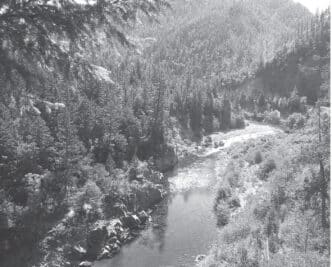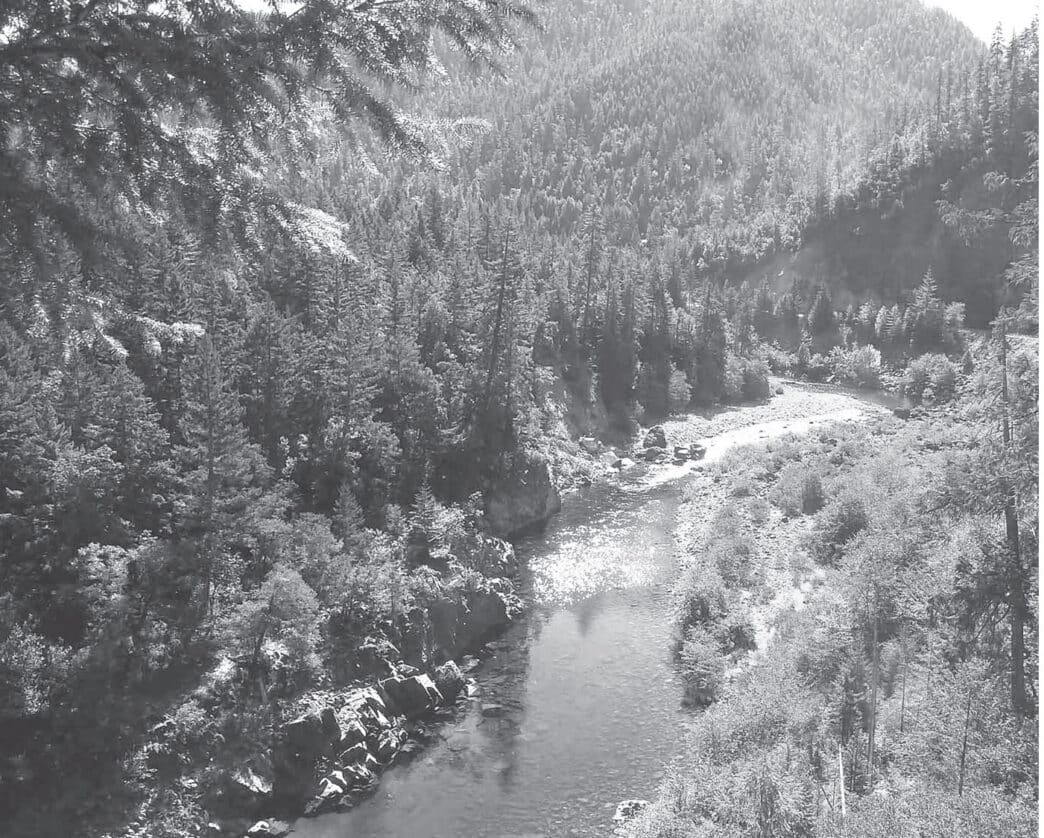The Smith is the most beautiful river I’ve ever seen.” That may sound like chamber of commerce hyperbole, but the quote is from Meade Fischer of Watsonville, a seasoned outdoor writer who has kayaked and written books about most Northern California waters. His latest is With the Sea Beside Me: An Intimate Guide to California’s Central and North Coast. He had just finished kayaking a stretch of the Smith on an outing with the Outdoor Writers Association of California. “The Smith is just incomparable to any other river,” Fischer said.
He was raving about California’s longest undammed river, which starts near the small town of Gasquet in the northwest corner of the state, tumbles through 25 miles of steep canyons in Del Norte County, and flows into the Pacific Ocean about 8 miles north of Crescent City. The Smith is fed by the 27.8-mile-long Middle Fork, the 28.1-mile-long North Fork, and the 43.3-mile-long South Fork. A number of smaller creeks in the Smith watershed in California and Oregon flow into the forks.
The river is known for its crystal-clear water, stunning canyons, fog-dappled redwood trees, whitewater rafting opportunities, and for fishing in one of the state’s last remaining wild river areas. The Smith’s flow is supported by runoff from its 719-square-mile basin — 629 square miles in California, and 91 square miles in Oregon. The Smith’s water clears more quickly than other coastal streams after major rain events, because it flows through bedrock rather than silt-laden areas. There are a lot of big flow events in normal rain years, because the Smith receives over 90 inches of rainfall annually.
The Smith is also known as a destination for fly anglers who want to tackle big, record-breaking salmon and steelhead, particularly during the fall and winter months. Most fishing guidebooks gush unabashedly about the angling.
“The river just grows big fish,” says Tom Steinstra, referring to salmon in The Complete Guide to California Fishing. “The same is true for steelhead. A 10-pounder is the average fish, 15-pounders are common, and more 20-pounders are caught here than any river in California.” Ken Albert’s Fishing in Northern California says: “From September on, large salmon run in the Smith. Steelhead usually begin to arrive in force in November and run through April. Numerous holes provide excellent holding waters for salmon and steelhead.” “Fishing the Smith River is every angler’s realization of how a salmon and steelhead river is supposed to look,” a blurb on a fishing-access map to the Smith and Chetco Rivers declares. “Beautiful, emerald water meandering through redwoods, quiet and big fish. Steelies in the 20-plus pound category are caught yearly in the Smith River. Typical steelhead run from eight to 12 pounds, with some 15 pound plus caught.”
The Smith produced the state record steelhead at 27 pounds, 4 ounces, in 1976, according to California Department of Fish and Wildlife records. According to a local fishing guide, the Smith’s record king salmon is 86 pounds, but that is not the California state record (the DFW says the record is an 88-pounder caught in 1979 in the Sacramento River. See the state fishing records at https://nrm.dfg.ca.gov/AnglingRecords.)
Angling regulations on the Smith can be complex, and closures can be imposed by the DFW to protect threatened fish, particularly during drought periods. Check their Web site at https://www.wildlife.ca.gov for updates and the California Department of Water Resources site at es.html for real-time water flows.
Besides its huge fish, the Smith is also known as a success story for watershed protection and restoration, with programs designed to sustain a population of wild coho and chinook salmon and coastal cutthroat and steelhead trout, according to Grant Werschkull, executive director of the 34-year-old Smith River Alliance conservation group. “What’s really amazing in terms of all our rivers in the nation is the landscape protection that’s been achieved here,” says Werschkull. “It started back in the 1930s with the Save the Redwoods League buying [private] land and transferring it to state parks to become part of the Jedediah Smith Redwoods State Park.”
Werschkull works out of a sparse office in the village of Hiouchi — population 301 — which is located slightly more than 7 miles east-northwest of Crescent City along Highway 199. Just a stone’s throw from the Smith River, the office has plenty of room to house Werschkull, his wife, Patty McCleary, who is the group’s deputy director, and a couple of staff members.
He revels in being able to spread out a huge topographic map to show his group’s nearly 35 years of work protecting great swaths of the Smith watershed from development. Part of the alliance’s conservation strategy has been to purchase private inholdings within larger tracts of public land, retaining ownership for conservation purposes or transferring or selling the land to state or federal agencies for restoration and management.
In the early years, Werschkull says, the alliance focused more on land protection through advocacy and special government designations. But more recently, in 2002, the Save the Redwoods League, his group, and others worked with the California Department of Parks and Recreation and other government funders in a successful effort to protect 25,000 acres of Mill Creek property at a cost of $60 million. Partners in this land-protection project included the California Wildlife Conservation Board, the Department of Fish and Wildlife, the California Coastal Conservancy, The U.S. Fish and Wildlife Service, and private donors. “Mill Creek is where we do a lot of our restoration,” Werschkull said, pointing to an area on the topo map. “It’s phenomenally productive in terms of salmonids. We have raised over $7 million for restoration on this property.” In addition to Mill Creek, the alliance and its agency and nonprofit partners protected 5,400 acres of Hurdygurdy Creek and a 9,400-acre property on Goose Creek, the largest tributary in the Smith River Basin. In 2002, the alliance took ownership of Rock Creek Ranch, on the South Fork of the Smith, which includes a house and an outdoor use area with showers and a kitchen to support youth camps, workshops, education, and events for alliance programs. Last year, the alliance expanded the ranch property by 100 acres. You can see more about the offerings at the ranch at http://smithriveralliance.org/welcome/.
In 1981, over 300 miles of the Smith River and its tributaries were added to the National Wild and Scenic Rivers system. In 1990, all of the U.S. Forest Service land in California within the watershed was included in the Smith River National Recreation Area (NRA). Together, the Wild and Scenic designations and the NRA prohibit construction of any dams and provide for management with a focus on recreation, restoration, and maintaining and improving the fisheries and wildlife resources.
“The NRA was created in response to a big strip-mining proposal in the Gasquet Mountain area,” Werschkull says, referring to an area adjacent to the Smith in the Six Rivers National Forest. “It took everybody to beat it down, including the State of California. That provided the impetus to provide additional protection in the basin.”
Werschkull notes that early work on the legislation focused on creating a Smith River National Park, but there wasn’t enough support in Congress. “The compromise was the NRA,” he points out, adding that it encompasses over 300,000 acres. “That prohibited new mining claims. The Oregon delegation wasn’t interested in participating, so 50,000 acres of the North Fork Smith in that state were not included. That’s where the strip-mine proposal is located right now.”
He is referring to the open-pit mine being planned by the Red Flat Nickel Corporation of England. They also have claims in the Red Flat area in the Hunter Creek and Pistol River watersheds, which are in the Rogue River–Siskiyou National Forest in southern Oregon.
“The proposed mine would be located southeast of the Kalmiopsis Wilderness within the Baldface Creek drainage and also in the adjacent headwaters of the wild and scenic Illinois River,” Werschkull wrote in an action alert to the alliance’s supporters. “The proposed mine area is a hot spot for coho salmon, and endangered species” in the headwaters of the Smith and Illinois Rivers.
Environmentalists and local, state, and federal officials became aware of the project when the Red Flat Nickel Corporation applied for a Oregon permit to use 10 gallons of water per minute from a tributary to the Smith as part of its effort to evaluate the feasibility of creating the proposed 4,000-acre open-pit mine. Government reports in the 1970s said the area contains significant amounts of nickel, cobalt, and chromium. Nickel is used in batteries that power everything from electric cars to cell phones.
The water-use proposal has been widely opposed by public agencies, environmental groups from around the region and the nation, and by the Del Norte County Board of Supervisors. “The Smith River is the indirect source for many water users in Del Norte County, with the largest user being the city of Crescent City,” the county’s July 8, 2014, opposition letter said. “It is with this in mind the Del Norte County Board of Supervisors adamantly opposes this application or any other application that would result in future strip mining in the Smith River watershed.” But Greg Peden, of Gallatin Public Affairs in Portland, who has been hired by the mining proponents, said in an interview on Jefferson Public Radio: “We need these metals. The U.S. needs these metals; the world needs these metals. And we think we can do it in an environmentally responsible way.”
After a review, the Oregon Water Resources Department rejected the firm’s request to drill the test holes, which has been trumpeted by conservationists as a temporary victory for their efforts. But Werschkull said that the decision is not the end of his group’s struggle, because the project proponents could helicopter in the water for its test for nickel.
“I wish it could mean that it is totally done, but it’s not,” Werschkull wrote in a press statement. “There is still the serious threat of strip mining. This foreign company has claims in that part of the headwaters of the Smith and also in the adjacent headwaters of the Illinois.”
Red Flat Nickel’s claim to mine the land has been made under the 1872 mining law, which was signed by President Ulysses S. Grant. The firm has 139 claims to mine in the Smith watershed. The Forest Service can reject mining claims under the law, but has been reluctant to do so in many cases, even those that involve the Smith, where “a few thousand” comments on review documents oppose the project.
Members of the Oregon and California delegations in Congress are considering introducing a bill that would remove the area targeted for mining from the 132-year-old law — a move that would have precedent-setting significance for mining practices across the nation. Such legislation would change the parameters of fishery conservation. If introduced and passed, such a new law could keep the Smith River flowing free for anglers to enjoy for generations.














